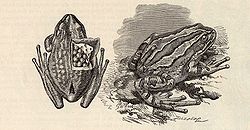| Gastrotheca marsupiata | |
|---|---|
 | |
| Scientific classification | |
| Kingdom: | Animalia |
| Phylum: | Chordata |
| Class: | Amphibia |
| Order: | Anura |
| Family: | Hemiphractidae |
| Genus: | Gastrotheca |
| Species: | G. marsupiata |
| Binomial name | |
| Gastrotheca marsupiata | |
| Synonyms | |
Hyla marsupiataDuméril and Bibron, 1841 | |
Gastrotheca marsupiata is a species of frog in the family Hemiphractidae. It is found in the Amazonian drainage systems of Andes from central Peru to southern Bolivia. Its common names are marsupian frog, common marsupial frog, and for now synonymized Leptodactylus/Eleutherodactylus andicola, Boettger's robber frog. [2] It is a locally common frog present in primary, secondary and disturbed cloud and montane forests in the valleys of the central Andes. [1]
